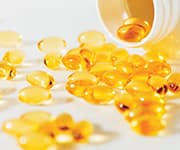Life Extension Magazine®
Starting around age 40, we lose roughly 8% of muscle mass per decade. After age 70, muscle mass decreases by about 15% per decade.1
This drastic decline in muscle mass is called sarcopenia. It increases the risk for falls and fractures, hospitalization,2 and disability.3,4
Eventually, frailty can set in, which speeds up passage on the road to lost independence and early death.5
Two nutrients have been shown to head off sarcopenia and frailty by rebuilding lost muscle mass in aging adults.
These can be added to a protein-sufficient diet or protein supplements that contain body-mass-building amino acids.
Maintained Muscle Mass
Beta-hydroxy beta-methylbutyrate, or HMB, is a compound created during metabolism of the amino acid leucine.6
HMB helps decrease muscle breakdown (called catabolism) and increase muscle buildup (anabolism).7-11
HMB levels decline with age, a drop that correlates with diminished muscle mass and strength.12
A 2015 meta-analysis found that oral intake of HMB preserved muscle mass in older adults and may help prevent muscle atrophy.13
One study showed that HMB intake could even preserve lean body mass in the face of sustained bed rest, a powerful stimulus for sarcopenia.14
Improved Exercise Results
HMB has also been shown to help boost lean body mass when used with resistance training.15,16
In one study, a group of 70-year-olds participated in a resistance training exercise program five days a week. During that time, they took one gram of HMB or a placebo three times a day.15
After eight weeks, those taking HMB had an increase in lean body mass of 1.76 pounds, while placebo recipients lost 0.44 pounds—despite exercising five days a week.
This study showed that HMB can augment strength training in older adults.
Vitamin D3 can complement that action by further enhancing muscle strength.
Vitamin D3 Boosts Strength
Sarcopenia, associated with problems with balance and gait, adds to the risk of falling and fractures in older individuals.17
Vitamin D3 intake improves muscle strength and performance.18,19
Studies show that it’s possible to increase muscle strength simply by boosting vitamin D levels.
Combat Four Underlying Factors of Sarcopenia
There are four primary factors that contribute to sarcopenia. HMB or vitamin D3 mitigates each of these underlying factors:
Factor #1:
Skeletal muscle protein imbalance causes muscle to break down faster than it is rebuilt.HMB exerts pro-anabolic (muscle build-up) and anti-catabolic (anti-breakdown) properties.9
Factor #2:
Declining sex hormone levels due to aging reduce muscle mass.Vitamin D supports sex hormone synthesis24 and muscle contractile strength.25
Factor #3:
Falling numbers and activity of mitochondria greatly contribute to sarcopenia.26Vitamin D3 signaling improves mitochondrial function and dynamics, which can increase muscle strength.27
Factor #4:
As muscles break down, levels of pro-inflammatory markers rise.28Vitamin D3 acts as an immune modulating hormone that can suppress inflammation associated with sarcopenia.29
A controlled trial of 160 postmenopausal women, aged 50-65, found that supplemental vitamin D3 provided significant protection against sarcopenia, as evidenced by an increase in muscle strength and control of progressive loss of muscle mass in the treatment group.20 Falls can happen because of inadequate muscle mass and poor coordination or balance.21
Vitamin D3 shows promise for combatting both factors.
Researchers assigned women to receive either 1,000 IU/day of vitamin D3 or a placebo. After nine months, those who took vitamin D had a 25.3% increase in leg muscle strength, while women in the placebo group lost 6.8% of their lean mass.20
A meta-analysis of clinical studies suggests that adequate intake of vitamin D not only preserves but also improves muscle strength.18 That’s an important finding, since loss of overall muscle strength can increase the risk of mortality.22
The greatest benefits were seen in those who had the lowest vitamin D levels at the beginning of the study (less than 12 ng/mL) and in older subjects.
Other studies have found that increased vitamin D intake in deficient elderly adults led to improved balance and a decreased risk of falls.23
Summary
HMB and vitamin D have been shown to combat sarcopenia and help prevent frailty by maintaining and boosting muscle mass and performance.
HMB contributes to improvements in strength and lean muscle mass, while vitamin D3 helps boost muscle strength and improve balance.
A combination of HMB and vitamin D3, along with adequate protein intake, may help maintain optimal muscle mass, strength, and function well into older age.
If you have any questions on the scientific content of this article, please call a Life Extension Wellness Specialist at 1-866-864-3027.
References
- Kim TN, Choi KM. Sarcopenia: definition, epidemiology, and pathophysiology. J Bone Metab. 2013 May;20(1):1-10.
- Beaudart C, Rizzoli R, Bruyere O, et al. Sarcopenia: burden and challenges for public health. Arch Public Health. 2014;72(1):45.
- Janssen I, Baumgartner RN, Ross R, et al. Skeletal muscle cutpoints associated with elevated physical disability risk in older men and women. Am J Epidemiol. 2004 Feb 15;159(4):413-21.
- Janssen I, Shepard DS, Katzmarzyk PT, et al. The healthcare costs of sarcopenia in the United States. J Am Geriatr Soc. 2004 Jan;52(1):80-5.
- Cesari M, Landi F, Vellas B, et al. Sarcopenia and physical frailty: two sides of the same coin. Front Aging Neurosci. 2014;6:192.
- Slater GJ, Jenkins D. Beta-hydroxy-beta-methylbutyrate (HMB) supplementation and the promotion of muscle growth and strength. Sports Med. 2000 Aug;30(2): 105-16.
- Smith HJ, Mukerji P, Tisdale MJ. Attenuation of proteasome-induced proteolysis in skeletal muscle by beta-hydroxy-beta-methylbutyrate in cancer-induced muscle loss. Cancer Res. 2005 Jan 1;65(1):277-83.
- Smith HJ, Wyke SM, Tisdale MJ. Mechanism of the attenuation of proteolysis-inducing factor stimulated protein degradation in muscle by beta-hydroxy-beta-methylbutyrate. Cancer Res. 2004 Dec 1;64(23):8731-5.
- Wilkinson DJ, Hossain T, Limb MC, et al. Impact of the calcium form of b-hydroxy-b-methylbutyrate upon human skeletal muscle protein metabolism. Clin Nutr. 2018 Dec;37(6 Pt A):2068-75.
- Wilson GJ, Wilson JM, Manninen AH. Effects of beta-hydroxy-beta-methylbutyrate (HMB) on exercise performance and body composition across varying levels of age, sex, and training experience: A review. Nutr Metab (Lond). 2008 Jan 3;5:1.
- Lin Z, Zhao A, He J. Effect of b-hydroxy-b-methylbutyrate (HMB) on the Muscle Strength in the Elderly Population: A Meta-Analysis. Frontiers in Nutrition. 2022 2022-July-13;9.
- Kuriyan R, Lokesh DP, Selvam S, et al. The relationship of endogenous plasma concentrations of b-Hydroxy b-Methyl Butyrate (HMB) to age and total appendicular lean mass in humans. Exp Gerontol. 2016 Aug;81:13-8.
- Wu H, Xia Y, Jiang J, et al. Effect of beta-hydroxy-beta-methylbutyrate supplementation on muscle loss in older adults: a systematic review and meta-analysis. Arch Gerontol Geriatr. 2015 Sep-Oct;61(2):168-75.
- Deutz NE, Pereira SL, Hays NP, et al. Effect of b-hydroxy-b-methylbutyrate (HMB) on lean body mass during 10 days of bed rest in older adults. Clin Nutr. 2013 Oct;32(5):704-12.
- Vukovich MD, Stubbs NB, Bohlken RM. Body composition in 70-year-old adults responds to dietary beta-hydroxy-beta-methylbutyrate similarly to that of young adults. J Nutr. 2001 Jul;131(7):2049-52.
- Sanz-Paris A, Camprubi-Robles M, Lopez-Pedrosa JM, et al. Role of Oral Nutritional Supplements Enriched with b-Hydroxy-b-Methylbutyrate in Maintaining Muscle Function and Improving Clinical Outcomes in Various Clinical Settings. J Nutr Health Aging. 2018;22(6):664-75.
- Available at: https://www.nia.nih.gov/health/falls-and-fractures-older-adults-causes-and-prevention#:~:text=Age%2Drelated%20loss%20of%20muscle,all%20risk%20factors%20for%20falling. Accessed December, 14, 2022.
- Beaudart C, Buckinx F, Rabenda V, et al. The effects of vitamin D on skeletal muscle strength, muscle mass, and muscle power: a systematic review and meta-analysis of randomized controlled trials. J Clin Endocrinol Metab. 2014 Nov;99(11):4336-45.
- Rejnmark L. Effects of vitamin d on muscle function and performance: a review of evidence from randomized controlled trials. Ther Adv Chronic Dis. 2011 Jan;2(1):25-37.
- Cangussu LM, Nahas-Neto J, Orsatti CL, et al. Effect of vitamin D supplementation alone on muscle function in postmenopausal women: a randomized, double-blind, placebo-controlled clinical trial. Osteoporos Int. 2015 Oct;26(10):2413-21.
- Gama ZA, Gomez-Conesa A. [Risk factors for falls in the elderly: systematic review]. Rev Saude Publica. 2008 Oct;42(5):946-56.
- Wang H, Hai S, Liu Y, et al. Skeletal Muscle Mass as a Mortality Predictor among Nonagenarians and Centenarians: A Prospective Cohort Study. Sci Rep. 2019 Feb 20;9(1):2420.
- Kougias DG, Das T, Perez AB, et al. A role for nutritional intervention in addressing the aging neuromuscular junction. Nutr Res. 2018 Feb 17;53:1-14.
- Kinuta K, Tanaka H, Moriwake T, et al. Vitamin D is an important factor in estrogen biosynthesis of both female and male gonads. Endocrinology. 2000 Apr;141(4):1317-24.
- Girgis CM, Clifton-Bligh RJ, Hamrick MW, et al. The roles of vitamin D in skeletal muscle: form, function, and metabolism. Endocr Rev. 2013 Feb;34(1):33-83.
- Marzetti E, Calvani R, Cesari M, et al. Mitochondrial dysfunction and sarcopenia of aging: from signaling pathways to clinical trials. Int J Biochem Cell Biol. 2013 Oct;45(10):2288-301.
- Ryan ZC, Craig TA, Folmes CD, et al. 1a,25-Dihydroxyvitamin D3 Regulates Mitochondrial Oxygen Consumption and Dynamics in Human Skeletal Muscle Cells. J Biol Chem. 2016 Jan 15;291(3):1514-28.
- Dalle S, Rossmeislova L, Koppo K. The Role of Inflammation in Age-Related Sarcopenia. Front Physiol. 2017;8:1045.
- Sassi F, Tamone C, D’Amelio P. Vitamin D: Nutrient, Hormone, and Immunomodulator. Nutrients. 2018 Nov 3;10(11).




